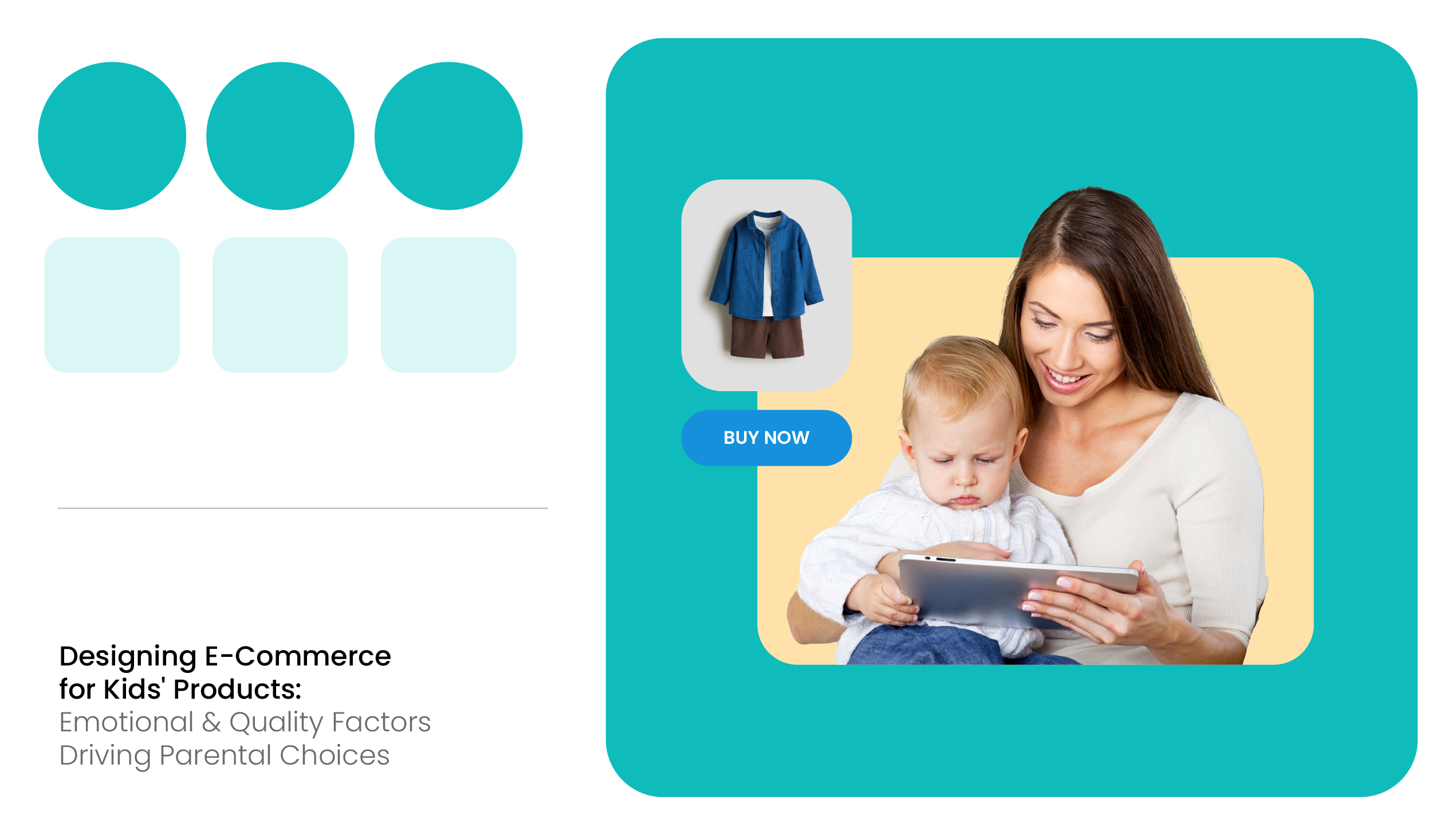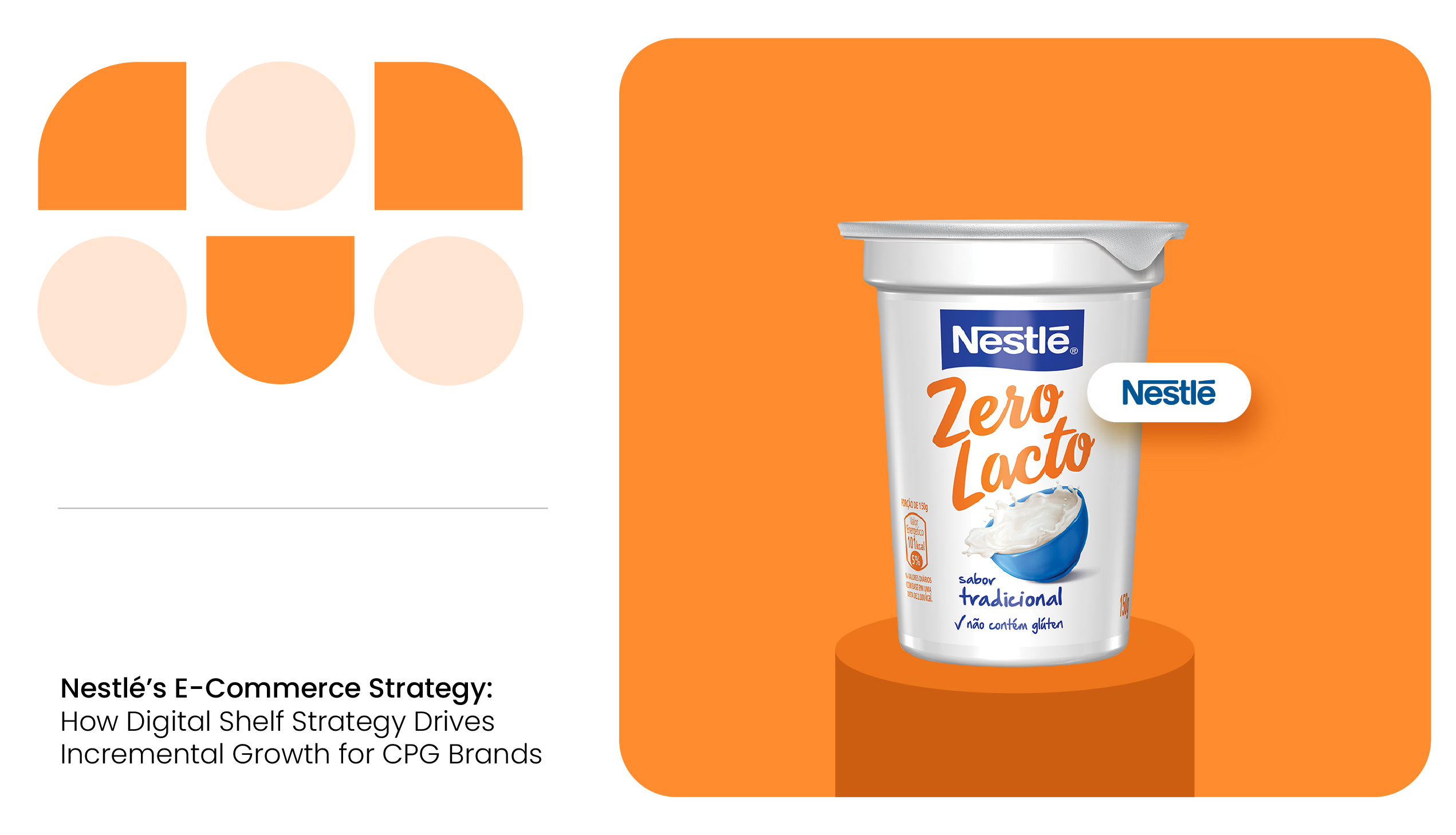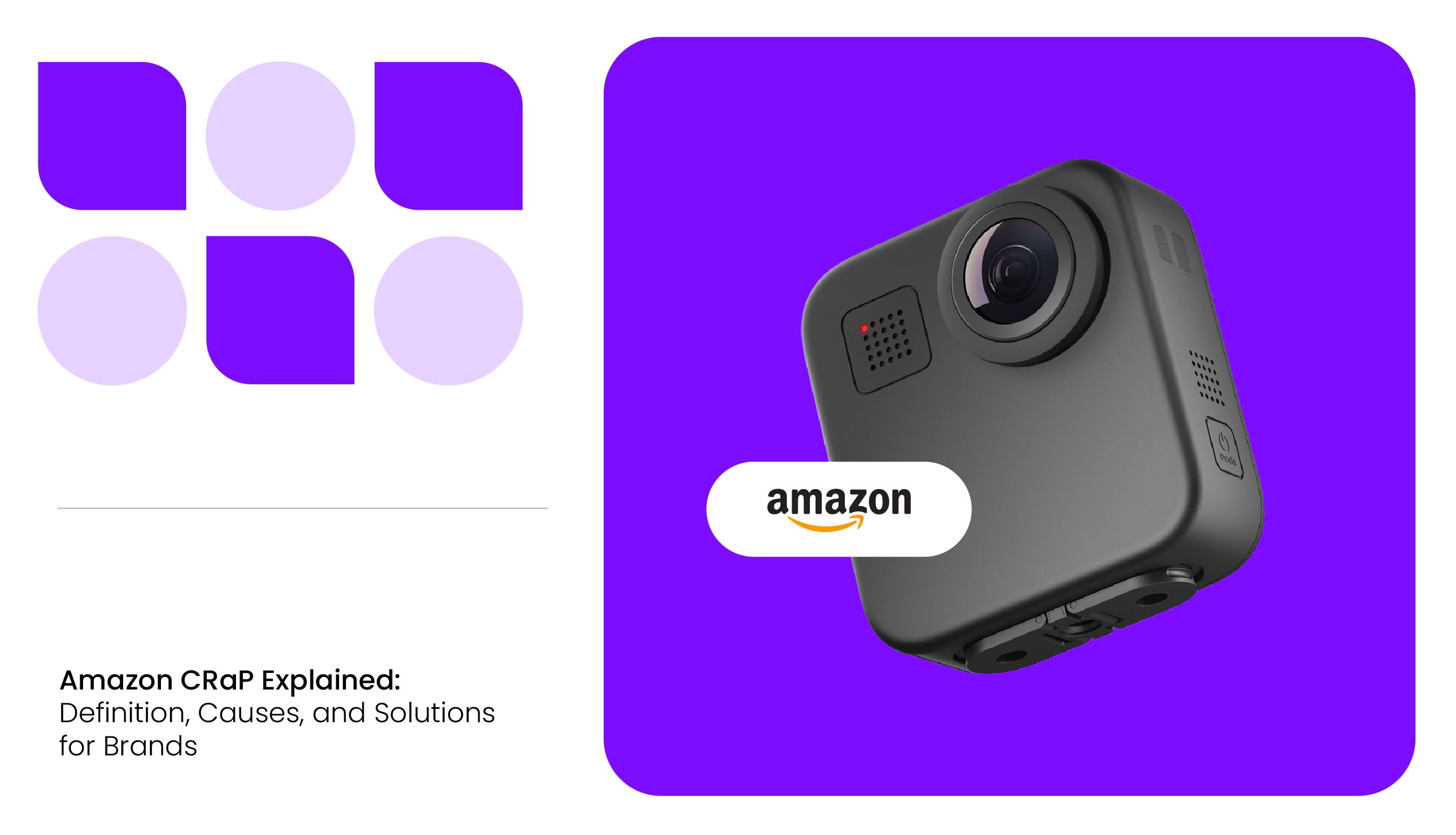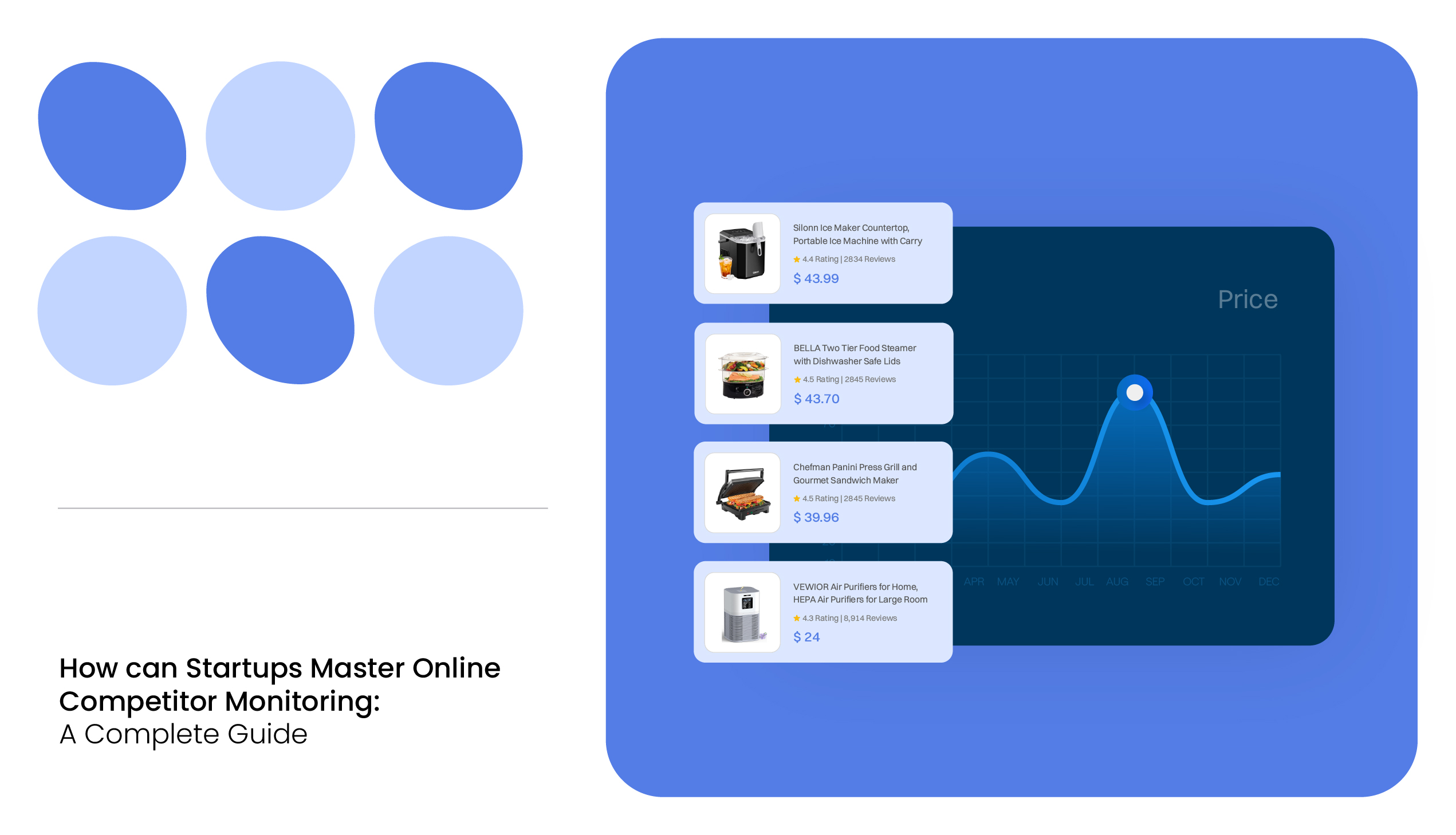When parents enter the digital marketplace for children’s products, they are not casual shoppers. Each purchase, whether a feeding bottle, a school backpack, or an educational app, feels like a reflection of their values and responsibility.
Parents are not asking, “Is this product affordable or stylish?” They are asking, “Is it safe? Will it help my child’s growth? Does it reflect the kind of parent I want to be?”
This duality explains why e-commerce for kids’ products has unique dynamics compared to other retail categories. Parents navigate decisions through both emotional filters (trust, pride, guilt, and avoidance) and rational filters (safety certifications, peer reviews, product quality).
According to a study that analyzed 16 global platforms, it was found that digital journeys in children’s categories must be personalized, empathetic, and transparent. Parents don’t want to scroll through generic catalogs; they want to be guided through experiences that reassure them emotionally and validate their rational concerns.
In this article, let’s explore why the success of e-commerce for kids’ products hinges not only on assortment and pricing, but also on how well it resonates with the parental psyche.
The Rise of E-Commerce in the Kids and Toys Sector
The children’s products industry has moved online at a remarkable speed. Before the pandemic, many parents still relied heavily on physical retail stores where they could see, touch, and evaluate items firsthand. But today, digital adoption has become dominant.
According to Straits Research, the online baby products retailing segment is projected to grow from $16.5 billion in 2025 to $35.4 billion by 2033, reflecting a CAGR of nearly 10%. Meanwhile, Verified Market Reports estimates the broader children’s products market will expand from $270 billion in 2024 to $411 billion by 2033.
Parents have discovered that digital platforms give them greater control: the ability to compare brands, evaluate reviews, verify certifications, and access a wider product range. They are also reassured by platforms that curate shopping experiences.
Platforms like Carter’s and Gymboree prove that curated journeys resonate more strongly with parents than endless catalogues.
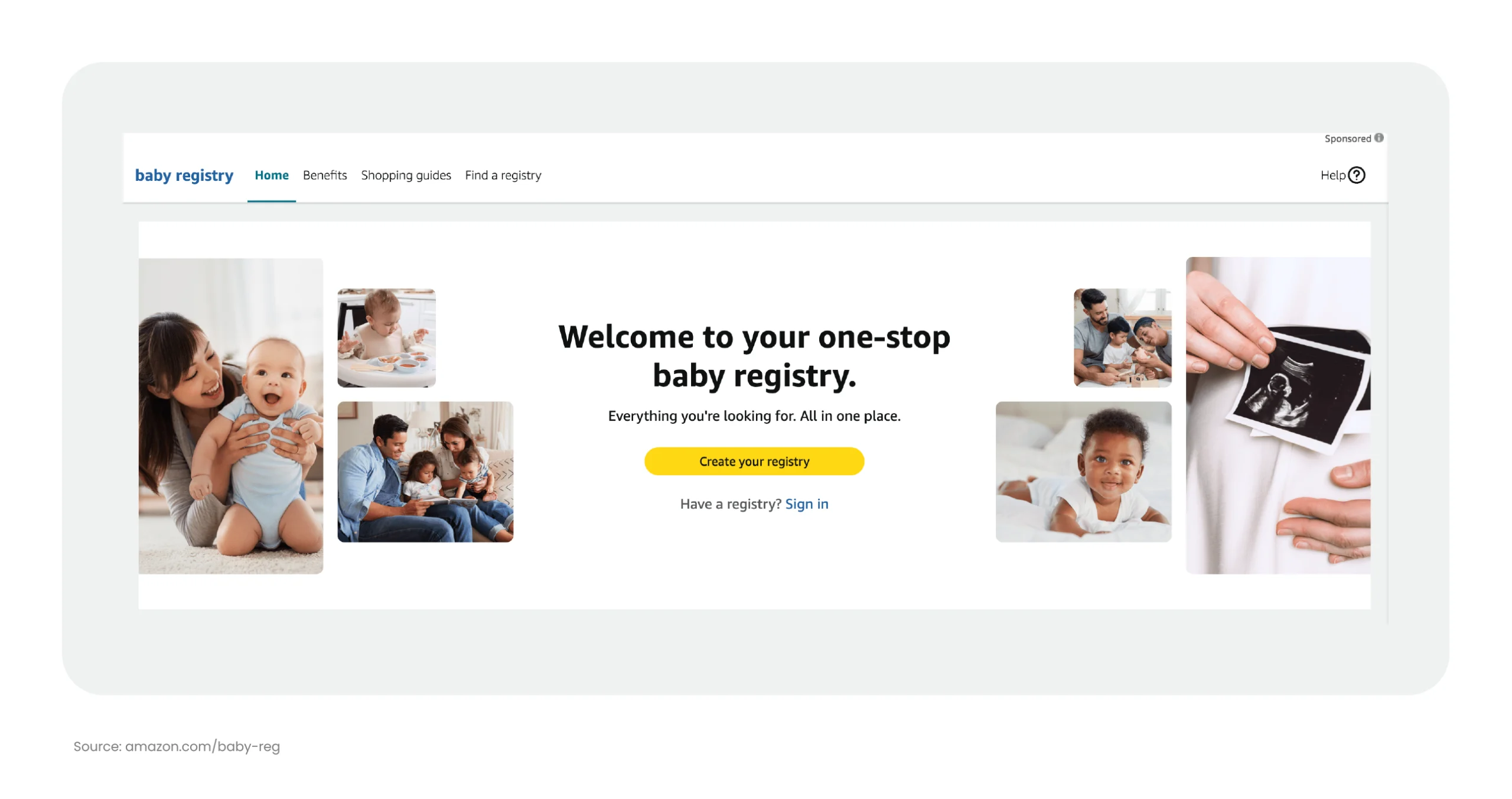
Generalist players are also adapting. Amazon has invested in parental trust through its Baby Registry, where products are filtered by age, safety, and peer ratings. Walmart has doubled down on affordability but has added safety filters and certifications, acknowledging that price is not the sole parental concern.
This evolution signals that e-commerce in kids’ categories is no longer transactional. It is a blend of reassurance, personalization, and credibility.
READ MORE | The online demand for toys is exploding! Check out The Future of Fun: Rising Trends in the US Online Toy Industry.
The Role of Emotions in E-Commerce for Kids’ Products
Emotions are the very foundation of purchase intent in this sector. Parents often enter online stores already guided by a strong set of needs and a desire to choose right.
Let’s explore the three most influential emotional levers in how parents make buying decisions online:
Emotional Triggers in Parents’ Buying Behavior
When buying for their children, parents don’t ask, “Does this product work?” so much as, “Does this product make me a better parent?” Emotional validation plays a huge role.
A parent may choose an eco-friendly diaper brand not only because it reduces rashes but because it aligns with their identity as a responsible, environmentally conscious caregiver. A STEM kit might be purchased not because it’s affordable, but because it makes the parent feel proactive in shaping their child’s future.
In a consumer behavior study, “trendy” (4.78/5), “pride” (4.68), and “surprise” (4.65) were rated higher than rational factors like price or functionality. These findings confirm the impact of emotions on buying decisions: parents are investing not only in products but in the symbolic meaning they hold.
Trust, Safety, and Care as Psychological Drivers
Of all emotions, trust is paramount. Parents cannot compromise on safety. Research emphasizes that platforms showcasing certifications, transparent manufacturing details, and quality assurances foster much higher levels of trust. Trust is not a one-time achievement; it is continuously reinforced by design elements, transparent communication, and post-purchase support.
For example, Amazon Baby Registry highlights safety icons, verified reviews, and parent-tested ratings up front. This creates a perception of care that extends beyond a single product to the platform itself. In kids’ categories, the role of emotions in customer behavior is not just persuasion, it’s reassurance.
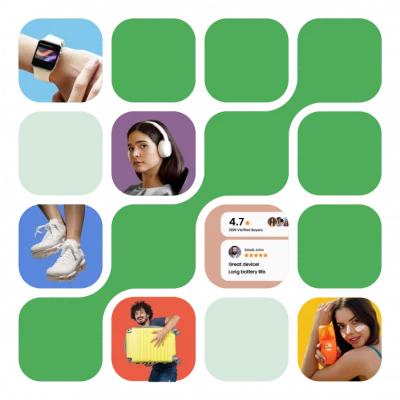
How Design Elements (Colors, Imagery, UX) Influence Feelings
Design is emotional storytelling. Colors, visuals, and interface choices subtly but powerfully influence parental perception. And with co-shopping on the rise, kids, too, are part of the decision-making process.
Warm pastel shades (often used in baby categories) evoke safety and calmness, while brighter tones (toys, games) inspire joy and playfulness.
Imagery matters equally. A product shown in use, such as a child happily playing with a toy in a safe setting, signals reassurance far more than a sterile product shot. UX flows matter too: simple navigation, easy-to-access safety info, and frictionless checkout reduce stress, reinforcing trust.
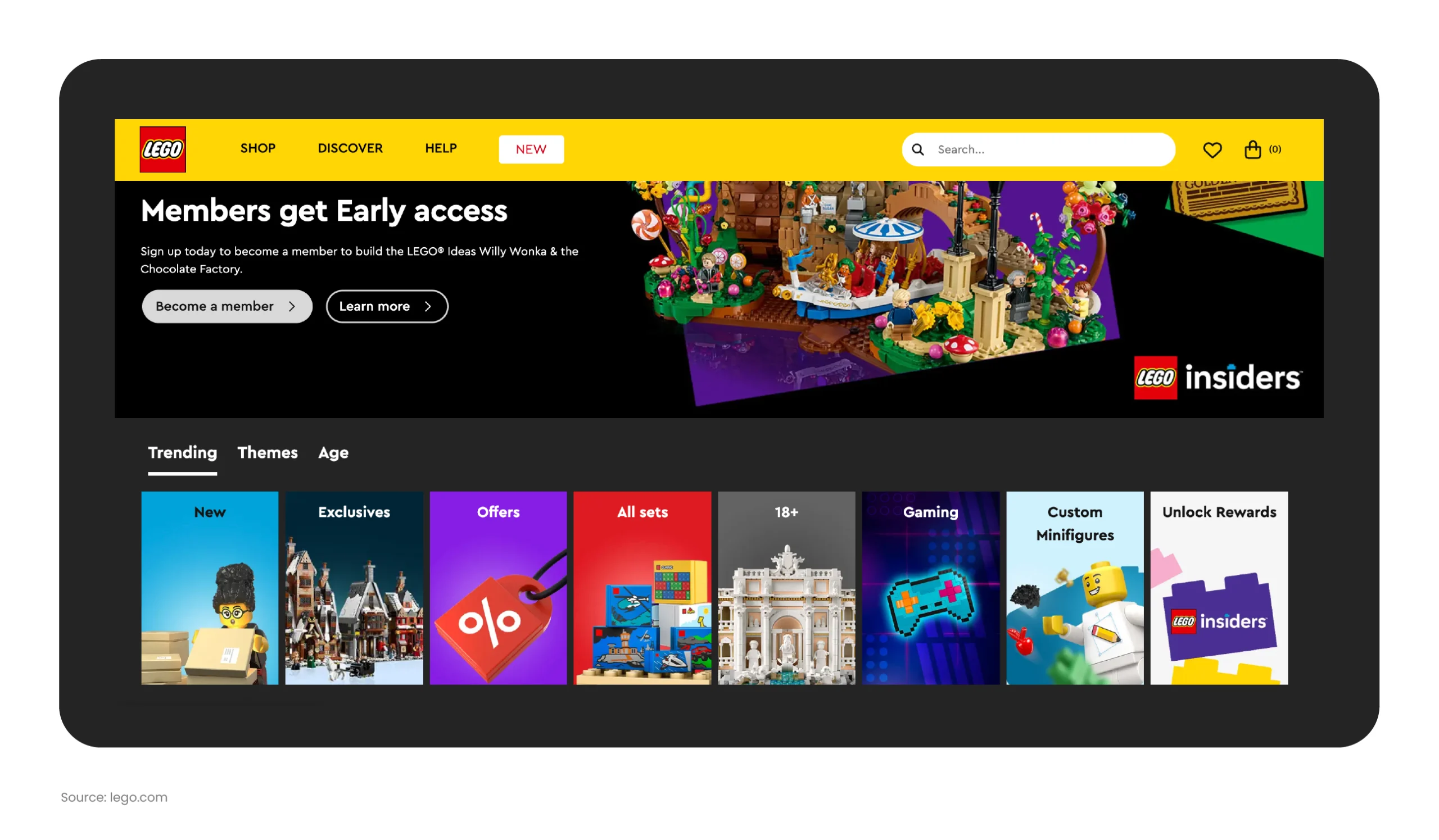
Take LEGO’s online store. The site isn’t merely a shopping hub; it’s an experience of storytelling, creativity, and reassurance. Parents don’t just see products; they see the joy, safety, and imagination that LEGO embodies, along with super-easy navigation. This is the role of emotion in purchasing, baked into design itself.
Quality as the Cornerstone of Parental Decision-Making
While emotions spark intention, rational quality checks determine conversion. Parents may be drawn in by pride or reassurance, but they finalize purchases through tangible validation.
Why Product Authenticity and Safety Matter Most
Parents have long memories when safety is breached. The Mattel 2007 recall of millions of toys with lead paint remains a cautionary tale, reminding brands that trust once lost is hard to rebuild. Modern parents expect clear certifications (EN71, ASTM, BPA-free), ingredient disclosures, and manufacturing origins.
Platforms that foreground these details on product pages, rather than bury them in fine print, signal transparency and earn parental trust. Without these, even the most emotionally resonant storytelling falls flat.
How Parents Evaluate Quality in Online Stores
Parents actively scrutinize, with nearly 80% ready to spend more money to ensure high quality. They study descriptions, material composition, and even washing instructions.
They watch product demo videos, not just for functionality but for reassurance of durability . They even compare listings and switch retailers; according to Deloitte’s Back-To-School survey, 2025, parents might shop at five retail formats on average, with value for money being the top concern.
Carter’s has excelled at this by blending storytelling with quality details; marketing clothes as “gentle comfort for your baby” while providing proof points like “100% organic cotton” and “machine washable.” This balance of emotion and rational detail satisfies both halves of the parental decision-making process.
The Power of Reviews, Ratings, and Certifications
Peer validation is one of the strongest rational reinforcements. According to The Shelf, nearly 78% of millennial parents rely on reviews before making online purchases for their children. Reviews provide not just reassurance but context: “This toy lasted through two toddlers” or “This formula eased my baby’s colic.”
Platforms like BuyBuyBaby combine certifications with verified parent testimonials on product pages. This dual reassurance, peer and professional, converts hesitant browsers into confident buyers. Reviews make the buying decision feel less risky and more like joining a trusted community of fellow parents.
With a ratings and reviews monitoring solution like MetricsCart, you can use customer sentiment analysis and thematic and sub-thematic analysis to decode what parents think about your brand and use the insights to fuel your R&D efforts.
Research firms and creative agencies also rely on us for market research and trend analysis; tracking emerging consumer behaviors, identifying emotional triggers, and spotting category shifts before competitors do.
READ MORE | Your next product development strategy is in your reviews! Check out Product Development Using Customer Feedback: Must-Know Tips for Brands.
Designing User-Centric E-Commerce Platforms for Kids’ Products
The most successful kids’ e-commerce platforms are not transactional; they are empathetic, designed around parental needs.
Personalization and Tailored Shopping Journeys
Parents don’t want to sift through irrelevant products. Platforms that personalize by age, need, or developmental stage create efficiency and trust.
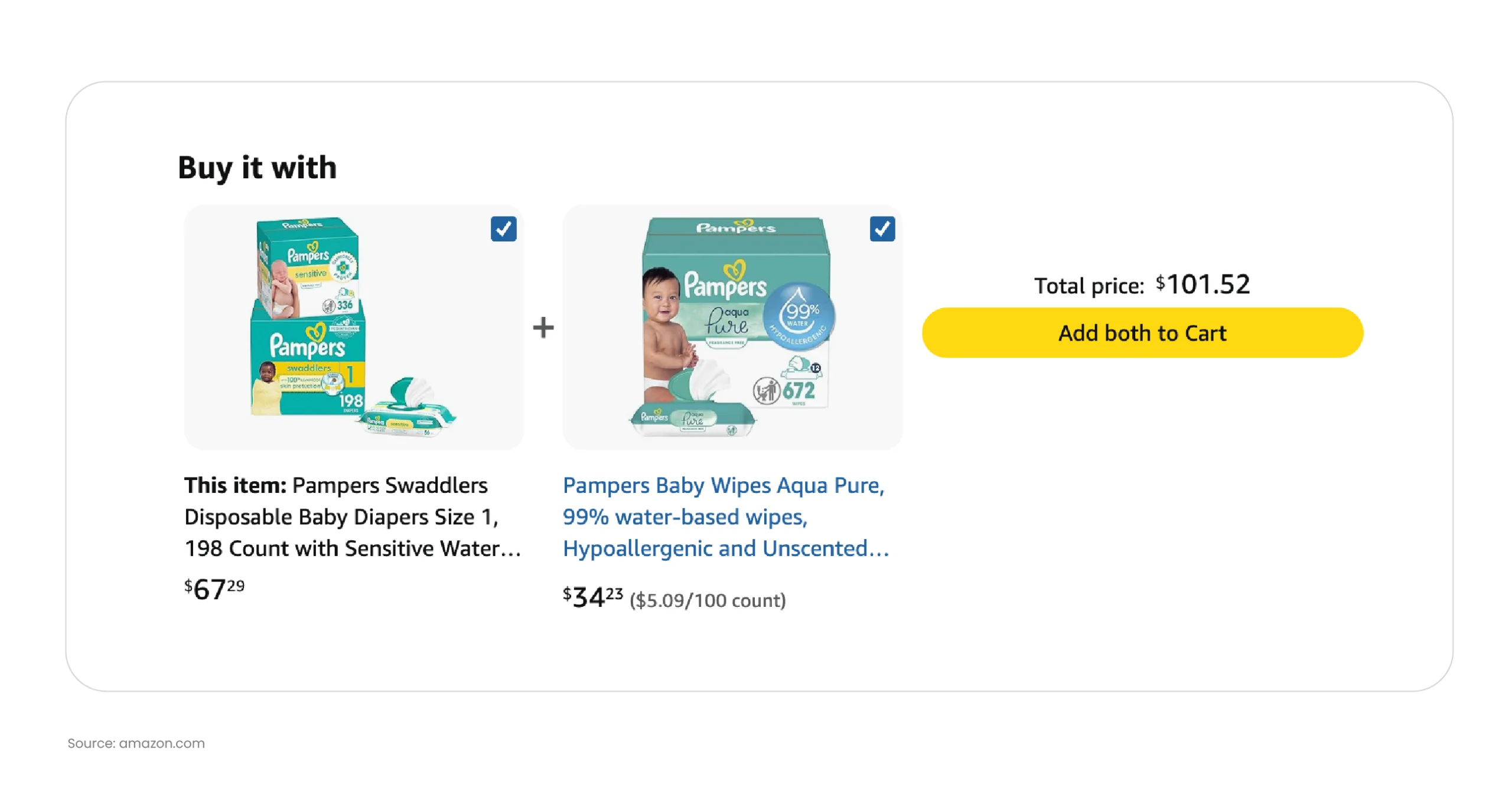
Amazon adds personalization with “Frequently Bought Together” or “Buy it with” suggestions that anticipate needs, such as diapers bundled with wipes, making parents feel understood.
Personalization in this category isn’t upselling; it’s empathy that strengthens customer loyalty.
Simplified Navigation for Time-Pressed Parents
Parents often shop in stolen moments, while feeding a baby or during school runs. They need frictionless navigation. Smart filters, such as “Organic only,” “Safety-certified,” or even age- and gender-specific classifications, allow for quick sorting. One-click checkouts or guest purchases eliminate hassle.
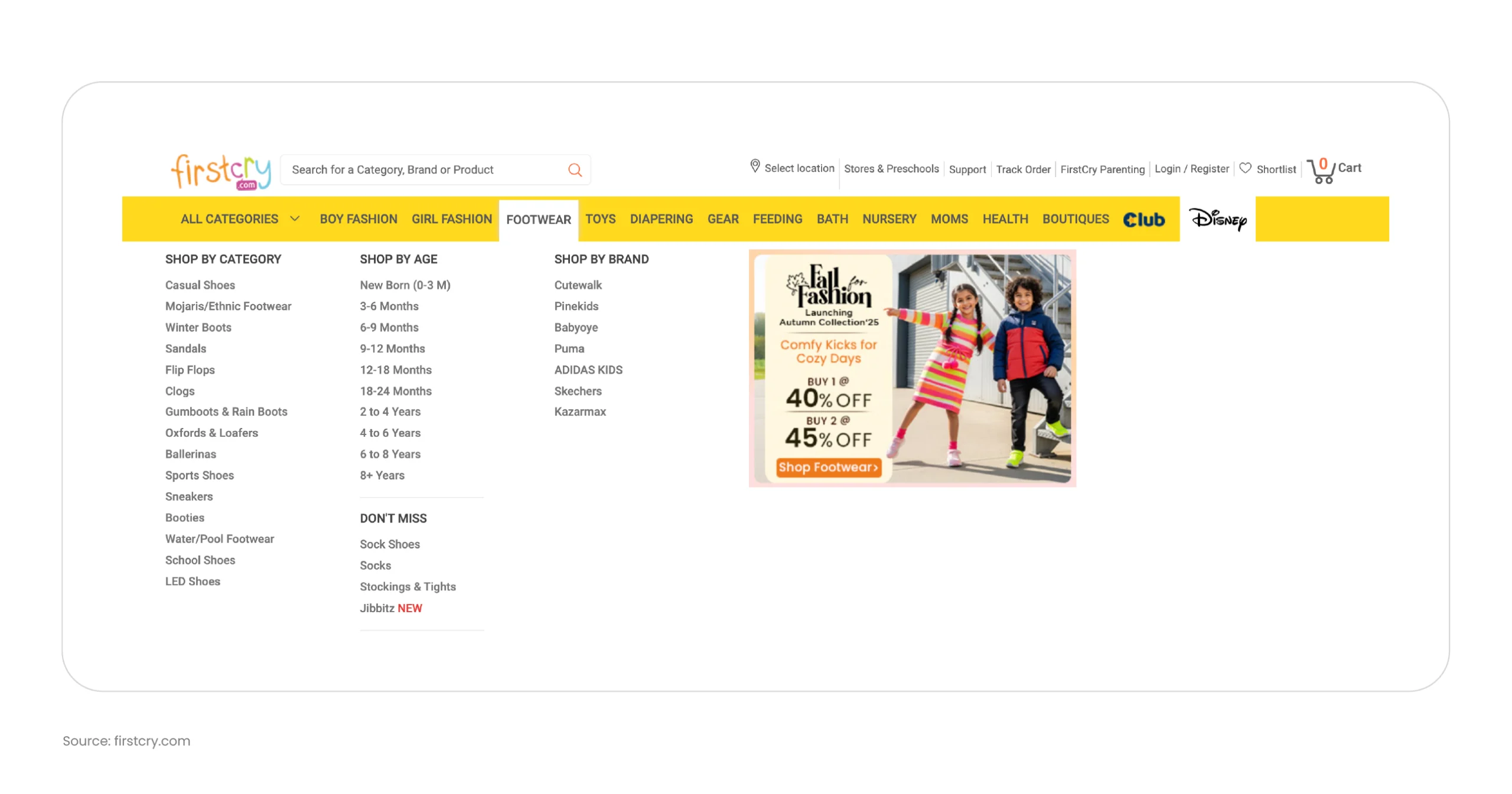
FirstCry does this by segmenting products into stages like “Newborn Essentials” or “Toddler Gear” and even has category and brand-specific filters to make the process hassle-free.
The Springer study found that simplifying navigation and streamlining checkout is one of the strongest drivers of satisfaction in children’s product e-commerce. Ease of navigation becomes a relief for busy parents, and this emphasizes the role of emotions on customer behavior in the kids’ category.
Mobile-First Design and Accessibility
Parents are predominantly mobile shoppers. They browse during commute breaks or with one hand free while holding a child. Mobile-first design, with large tap zones, responsive layouts, and fast checkout flows, is no longer optional. Accessibility features like high contrast, scalable text, and text-to-speech functionality extend inclusivity.
By accommodating these real-world contexts, platforms signal an understanding of the parental lifestyle and ensure a smoother shopping experience. That empathy translates directly into trust and loyalty.
READ MORE | Check out this detailed Digital Shelf Insights report on the Best Selling Baby Products on Amazon.
The Future of E-Commerce for Kids’ Products
AI personalization will anticipate developmental needs, recommending age-appropriate toys, allergy-safe foods, or milestone kits.
AR visualization will let parents virtually place a crib in their nursery or preview clothing sizes on a digital child model. Subscription models, already popular for diapers and formula, will grow as trust-driven loyalty ecosystems, eliminating stress for recurring needs.
Studies highlight the emergence of phygital journeys; hybrid experiences where digital browsing integrates with physical interaction. Imagine a toy purchased online that comes with a QR code unlocking an interactive learning app. Or an in-store purchase supported by personalized online recommendations.
These models will dominate because they blend convenience, emotion, and engagement. Plus, with co-shopping, as Gen Alpha has an increasing share in the buying decisions of their parents, brands must ensure that their strategies involve their direct consumers in the conversation too!
The future isn’t about selling products; it’s about becoming a trusted partner in parenting and upholding quality and the role of emotion in purchasing.
Let’s Wrap Up
Parents are not simply consumers in this category. They are protectors, nurturers, and role models. Every online purchase for their children is filtered through this identity. That’s why e-commerce for kids’ products must be designed differently.
Emotion guides intent: love, trust, care. Quality validates decisions: safety, authenticity, and reviews. Together, they shape how parents make buying decisions online. Platforms that master this duality will not just convert carts; they will create loyal, trusting communities of parents.
For e-commerce leaders, the task is straightforward: design not for transactions, but for trust.
To thrive in this category, you need insights into emotional drivers and rational trust signals. MetricsCart enables you to analyze review sentiment, track the impact of strategies, and benchmark against competitors. Book a free walkthrough to see how our solutions can help you win customers and scale online.
Ready To Take Control of Your Brand Performance? Strategize Smarter With MetricsCart!
FAQs
Emotions shape the way parents interpret products and platforms. When buying for children, parents often look for products that don’t just serve a function but also reflect their values. A baby blanket isn’t just fabric; it’s a symbol of care, warmth, and safety. Parents are drawn to items that make them feel they are protecting or nurturing their child. That emotional reassurance often outweighs rational concerns like price or convenience.
Yes, especially in the children’s category. Parents are highly protective, so emotions like pride, safety, and trust often guide their decision-making. A toy, for example, may be chosen not only for its educational benefit but also for the joy it promises to bring to a child. Emotional confidence in a product frequently becomes the deciding factor between two similar options.
Product reviews act as social proof and emotional reassurance. Parents trust the experiences of other parents more than marketing messages. A detailed review describing how a stroller made daily routines easier or how a toy kept a toddler engaged helps buyers visualize the product in their own lives.
Trust comes from clarity and transparency. Parents feel more confident when they see safety certifications, clear product descriptions, and authentic images of items being used in real-life settings. Easy-to-understand return policies and accessible customer support also signal that the platform will stand behind its products. Together, these features communicate that the brand values the well-being of children as much as parents do.
Design is more than aesthetics; it’s an emotional and functional guide. Parents are often short on time, so clean layouts, intuitive navigation, and quick filtering options make shopping less stressful. Visual cues like warm colors, family imagery, and easy-to-read fonts also help parents feel more at ease. A thoughtful, mobile-first design communicates empathy, showing parents that the platform understands their daily challenges and has created a space tailored to them.

